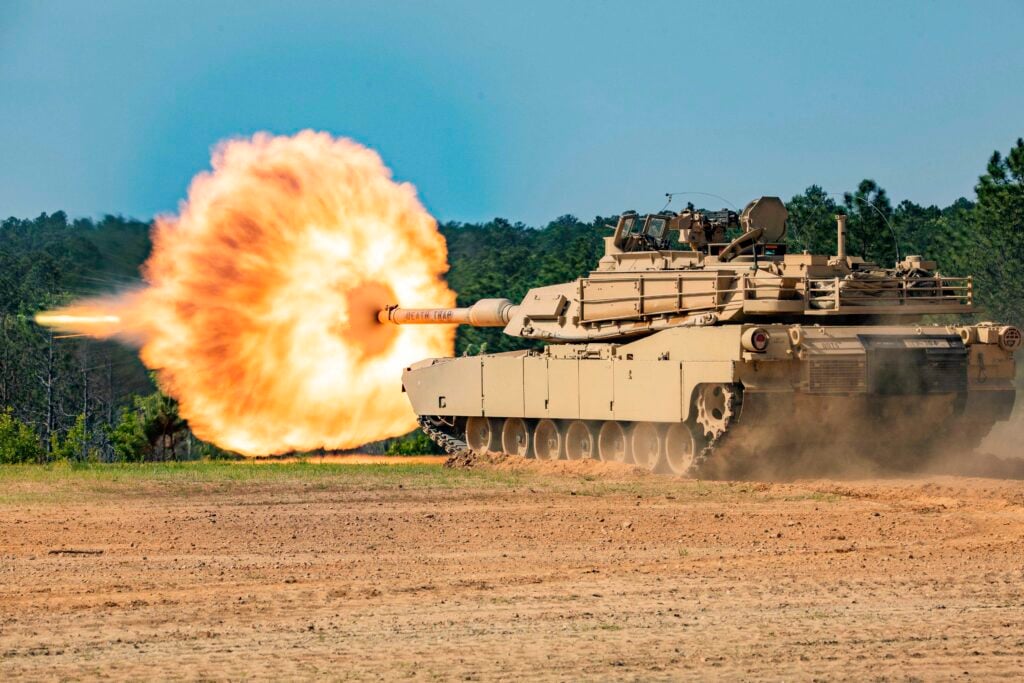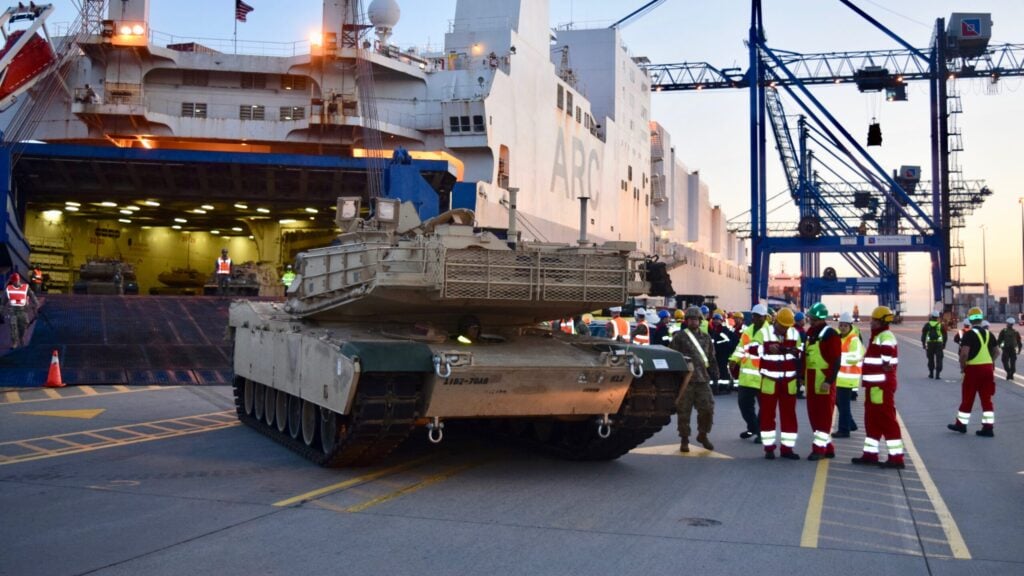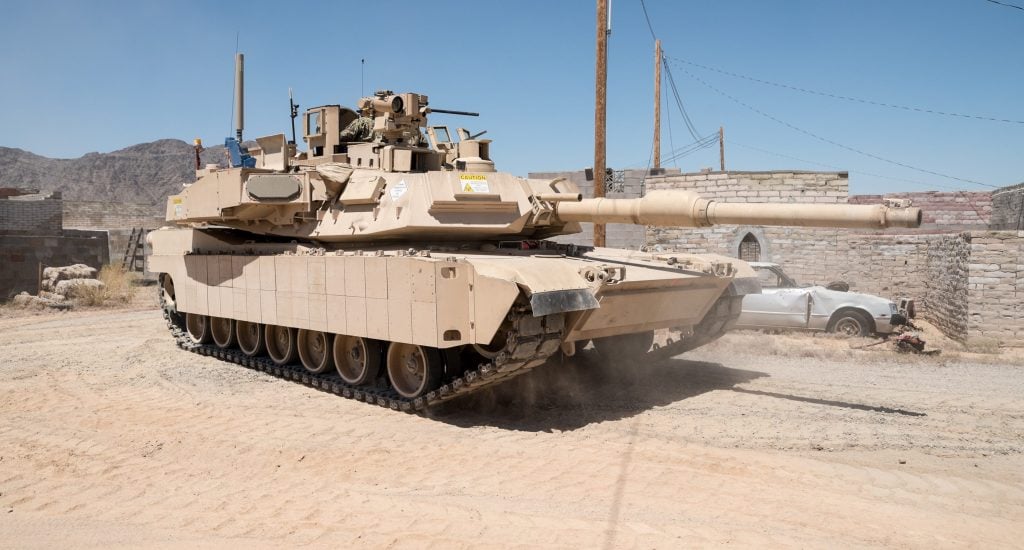ASHLEY ROQUE and SYDNEY J. FREEDBERG JR.

An M1A2 fires during a competition at Fort Benning, Ga. in 2022 (Army photo by Spc. Joshua Taeckens)
WASHINGTON — In the wake of the dramatic announcement by President Joe Biden this week that American-made Abrams main battle tanks will be sent to Ukraine, the White House and the Pentagon have left a myriad of questions unanswered. What specific kind of Abrams will be fending off Russian forces? When exactly will these tanks be delivered and ready for combat? And what kind of process did the Pentagon go through, or is still going through, to come to those decisions?
Statements from senior military officials suggest key details remain unresolved — including the specific variant and sub-variant of the Abrams in play. The same day as Biden’s announcement, Assistant Secretary of the Army for Acquisition, Logistics, and Technology Douglas Bush told reporters that he was still creating a laundry list of options for Pentagon officials to consider before deciding which way to go.
“It’s not just the tanks,” he said. “We have to be able to [deliver] tanks, support equipment, the training, the ammunition, the fuel… It’s really a bigger picture.”
Just a day later, Deputy Pentagon Press Secretary Sabrina Singh told reporters the Defense Department had settled on the M1A2 variant. The decision was made, in part, because the US does not have an “excess” of Abrams tanks of the earlier, less sophisticated M1A1 model in its stock, she said.
Later that day, however, a Pentagon spokesperson told Breaking Defense, “While we’re not able to provide specific details on the specifications of the variant at this time, it is our intent to procure the M1A2 tank through the Ukraine Security Assistance Initiative (USAI) funding even as we consider several other options.” That wording suggests the question of the M1A2 remained at least partly open, as is the question of which of several sub-variants the US was comfortable giving Kyiv.
As for the delivery timeline, a senior administration official told reporters the same day as Biden’s announcement that it would take “months as opposed to weeks” to deliver the vehicles to Ukraine. In the meantime, the US would establish a comprehensive training program for Ukrainian forces and set up the necessary maintenance and logistics infrastructure. Beyond that, exact estimates on when Ukrainian crews could be manning Abrams in combat were scarce, as was information about exactly where the tanks would come from.
The key is creating intelligent gateways that connect networks and the cloud across security domains and translate data so the joint services can speak the same language.
In the meantime, the Ukrainians are expected to more quickly absorb and fight with German Leopard tanks, whose transfer was announced the same day as the Abrams. But while the Pentagon deliberates and plans, there’s time to look at some options. What Abrams models are available, where are they, and how fast could they get to Ukraine?

A US Army M1A2 Abrams heavy tank unloads from a transport ship in Poland in 2017. (Photo Credit: Capt. Orlandon Howard)
Tanks Already In, Or Heading To, Europe
If the Pentagon sticks to its current plan and uses USAI for the Abrams, that means it won’t be pulling from active US stocks like a presidential drawdown would, so Army tanks in the US are most likely safe.
But if plans change, perhaps the fastest way to get Abrams tanks to Ukraine would be for the US to pull from its Army Prepositioned Stocks (APS) already in Europe. Retired Lt. Gen. Ben Hodges, a former commander of US Army forces in Europe, said the US should have all the equipment for two US Army armored brigades — including about 87 late-model M1A2 tanks each — already on the continent. APS stockpiles are intended for Army units to roll out in an emergency, but, Hodges argued, aiding Ukraine should qualify. (Biden said the US plans to send Ukraine 31 Abrams tanks, enough for one Ukrainian battalion.)
“If the administration had the sense of urgency to help Ukraine win, then they’d bring Ukrainian tank crews and commanders to Poland or Germany to match them up with these tanks for training and then put them on a train to Ukraine to be employed how and where and when the Ukrainian General Staff is ready,” he wrote in a Jan. 26 email to Breaking Defense. “This could all happen within the next two or three months.”
Older versions could also be available, because the Marine Corps disbanded its tank fleet in 2021 and transferred more than 400 M1A1s to the Army. The state of these vehicles is not publicly known, but the US State Department is currently selling some of those to countries including Poland, the first European nation to receive a US Abrams tank deal.
Warsaw announced earlier this month that it inked a deal to begin receiving 116 M1A1s later this year, in addition to a previous deal for 250 upgraded M1A2s that are expected to be delivered mid-decade. Poland’s announcement showcases the relative speed of delivery for the legacy M1A1s versus the M1A2 tanks. (The US Army has not responded to questions about the latter’s current production timeline.)
A host of factors come into play for production delivery dates, industry officials have explained in the past: The process is traditionally like a queue, so when an order comes in, it gets in line behind other deals. In this case, Ukraine would be getting in line behind existing US orders, including ones from countries like Poland and Taiwan. But here’s the catch: The administration can re-prioritize the queue and bump Ukraine up ahead of other countries already waiting for years.
The State Department did not immediately respond to questions about the Abrams tank production line and whether this week’s Ukraine announcement has any bearing on other orders for M1A1s or M1A2s.
Singh and other defense officials have also used the word “new” when referring to M1 Abrams bound for Ukraine. However, they probably don’t mean that in its most literal sense. The Army is not producing new tanks, but instead it is working with prime contractor General Dynamics, and other industry partners, on upgrades to existing hulls, drawn from a vast surplus of M1s demobilized after the Cold War. Establishing a production line for “new” Abrams would certainly be one way to delay delivery for years.

US Army M1 Abrams tank with Trophy Active Protection Systems (APS) and improved protection for machinegun operator. (Rafael photo)
The Devil In The Sub-Variant Details
In order to figure where the tanks should come from, the Pentagon first has to decide which types of tanks to give Ukraine.
The administration has obscured the details, likely in part on purpose to keep the Russians guessing, and in part because policy has changed so fast that at least some officials seemed to be getting whiplash. But there’s also a delicate balance to be kept between providing maximum performance to Ukraine and exposing American secrets to capture by Russia.
While all M1 Abrams models use the same AGT1500 engine, they vary widely in their armor, electronics, and even weapons. The original M1 introduced in 1980 had an already-obsolescent 105 mm main gun, but as soon as possible the Army swapped it out for the much more potent Rheinmetall 120 mm, also used on most Leopard 2s. (If any 105 mm M1s still exist, they’re in deep storage and would take months to overhaul.)
The first upgunned model was the M1A1, made in several subvariants with steadily stronger armor — M1 armor is modular, so you can replace outdated or battle-damaged slabs for new ones — and better electronics, such as GPS navigation and intelligence-sharing networks.
The latest variant is the M1A2 — the one Ukraine will get, at least based on most recent statements — which keeps the 120 mm main gun, modified to take new types of ammunition, but radically upgrades the electronics. The most important upgrade was a high-tech targeting system called the Commander’s Independent Thermal Viewer. In essence, the CITV is a mini turret atop the main turret, with its own set of sensors able to swivel in any direction, so while the gunner is lining up one target, the tank commander is already scanning for the next. Since most tank battles since World War II come down to who shoots (accurately) first, the A2’s “hunter-killer” system is a lethally important upgrade over the M1A1 — not to mention most of the Soviet-era tanks Russia and Ukraine still use.
The basic M1A2 has been upgraded several times, especially its electronics, which have become more modern and easier to maintain with every overhaul. The first System Enhancement Package improved the armor. SEPv2, the current mainstay model, focused on improved computers, network communications, and second-generation infrared sights. SEPv3, in production since 2018, upgrades protection against roadside bombs and adds an armor-protected Auxiliary Power Unit to keep running all the tank’s electronics while the gas-guzzling engine is turned off. (Earlier Abrams had an APU kludged on outside the armor, where a stray bullet could turn it to scrap). SEPv4, now in development, features a new laser sight and third-generation infrared sensors. Both SEPv3 and v4 are compatible with the Trophy Active Protection System, a kind of mini-missile defense that shoots down incoming anti-tank missiles and RPGs, but Trophy is in short supply and made in Israel, which has generally not allowed weapons exports to Ukraine.
Sources are cagey about other details related to the upgrades because so much of it is classified, and the US has to weigh its desire to give Ukraine the best tanks available with the limited numbers of the very latest models and the danger of one falling into hostile hands.
The US is especially sensitive about the M1’s armor, which for all current variants reportedly includes plates of ultra-dense depleted uranium. DU is non-radioactive — in fact, it’s less reactive than regular uranium, because all the radioactive isotopes have been removed to make nuclear fuel, which is why it’s called “depleted” — but it’s potentially toxic if ingested or inhaled, as could happen to the tank crew if an enemy round slams through the plate. (In that case, though, the crew has more immediate problems).
So every Abrams sold to foreign customers, even close allies like Australia, has the depleted uranium armor removed. Some of the older M1A1s being prepped for export, say to Poland, may have already had this process performed. But the more modern M1A2s all have the DU plates, and swapping them out adds weeks to the delivery timeline.
In the end, it could be many days or weeks before all these details are settled. In the meantime, the conversation appears to have moved on to what’s the next key weapon system for Ukraine’s fight against Russian invaders.
No comments:
Post a Comment